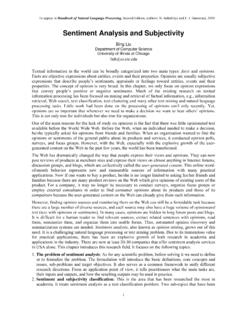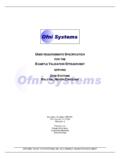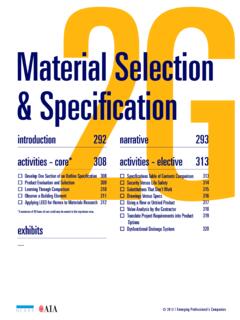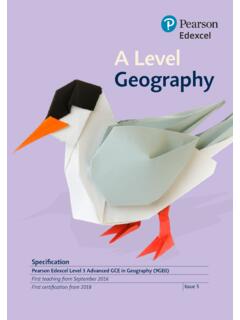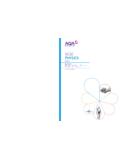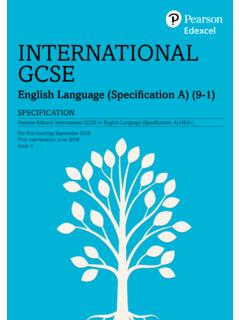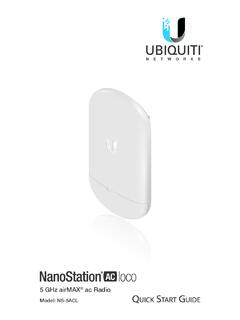Transcription of Requirements Specification Template
1 Volere Requirements Specification Template E d i t i o n 1 3 A u g u s t 2 0 0 7 by James & Suzanne Robertson principals of the Atlantic Systems Guild The Volere Requirements Specification Template is intended for use as a basis for your Requirements specifications. The Template provides sections for each of the Requirements types appropriate to today's software systems. You may download a pdf version from the Volere site and adapt it to your Requirements gathering process and Requirements tool. The Volere site also has a Word RTF version. The Template can be used with Requisite, DOORS, Caliber RM, IRqA and other popular tools. The Template may not be sold, or used for commercial gain or purposes other as a basis for a Requirements Specification without prior written permission.
2 We encourage you to see the donation notice. The Template may be modified or copied and used for your Requirements work, provided you include the following copyright notice in any document that uses any part of this Template : We acknowledge that this document uses material from the Volere Requirements Specification Template , copyright 1995 2007 the Atlantic Systems Guild Limited. Copyright the Atlantic Systems Guild Limited Volere Template /2 Contents Project Drivers 1. The Purpose of the Project 2. The Client, the Customer, and Other Stakeholders 3. Users of the Product Project Constraints 4. Mandated Constraints 5. Naming Conventions and Definitions 6. Relevant Facts and Assumptions Functional Requirements 7. The Scope of the Work 8. The Scope of the Product 9. Functional and Data Requirements Nonfunctional Requirements 10.
3 Look and Feel Requirements 11. Usability and Humanity Requirements 12. Performance Requirements 13. Operational and Environmental Requirements 14. Maintainability and Support Requirements 15. Security Requirements 16. Cultural and Political Requirements 17. Legal Requirements Project Issues 18. Open Issues 19. Off-the-Shelf Solutions 20. New Problems 21. Tasks 22. Migration to the New Product 23. Risks 24. Costs 25. User Documentation and Training 26. Waiting Room 27. Ideas for Solutions Copyright the Atlantic Systems Guild Limited Volere Template /3 Fair Use and Donating The first edition of the Volere Requirements Specification Template was released in 1995. Since then, organizations from all over the world (see experiences of Volere users at ) have saved time and money by using the Template as the basis for discovering, organizing, and communicating their Requirements .
4 Please be aware this Template is copyright The Atlantic Systems Guild Limited, and is intended to form the basis of your Requirements Specification . It may not be sold or used for commercial gain or other purposes without prior written permission. Please include the copyright notice in all uses. Updates to this Template are posted on our web sites at and The Volere Requirements process is described in the book Mastering the Requirements Process Second Edition by Suzanne Robertson and James Robertson, Addison-Wesley, 2006. ISBN 0-321-41949-9 You may download the Template , try it and decide whether or not it's right for your project. If you use it, we ask that you make a donation for each project using it Euro 40, USD50, GBP30 AUD70 or the equivalent to entitle your project to continue using the Template .
5 Academic institutions and students are exempt from this arrangement, but by no means discouraged from donating. Your donations pay for improving and upgrading the Template . You can make a donation by sending a cheque (or check if you prefer) to: The Atlantic Systems Guild Limited 11 St Mary's Terrace London W2 1SU United Kingdom or in the United States to: The Atlantic Systems Guild Inc. 353 West 12th Street New York NY 10014 United States Copyright the Atlantic Systems Guild Limited Volere Template /4 Volere Volere is the result of many years of practice, consulting, and research in Requirements engineering. We have packaged our experience in the form of a generic Requirements process, Requirements training, Requirements consultancy, Requirements audits, a variety of downloadable guides, and this Requirements Template .
6 We also provide Requirements Specification - writing services. Public seminars on Volere are run on a regular basis in Europe, the United States, Australia, and New Zealand. For a schedule of courses, refer to Requirements Types For ease of use, we have found it convenient to think of Requirements as belonging to a type. Functional Requirements are the fundamental or essential subject matter of the product. They describe what the product has to do or what processing actions it is to take. Nonfunctional Requirements are the properties that the functions must have, such as performance and usability. Do not be deterred by the unfortunate type name (we use it because it is the most common way of referring to these types of Requirements ) these Requirements are as important as the functional Requirements for the product s success.
7 Project constraints are restrictions on the product due to the budget or the time available to build the product. Design constraints impose restrictions on how the product must be designed. For example, it might have to be implemented in the hand-held device being given to major customers, or it might have to use the existing servers and desktop computers, or any other hardware, software, or business practice. Project drivers are the business-related forces. For example, the purpose of the project is a project driver, as are all of the stakeholders each for different reasons. Project issues define the conditions under which the project will be done. Our reason for including them as part of the Requirements is to present a coherent picture of all factors that contribute to the success or failure of the project and to illustrate how managers can use Requirements as input when managing a project.
8 Copyright the Atlantic Systems Guild Limited Volere Template /5 Testing Requirements Start testing Requirements as soon as you start writing them. You make a requirement testable by adding its fit criterion. This fit criterion measures the requirement, making it possible to determine whether a given solution fits the requirement. If a fit criterion cannot be found for a requirement, then the requirement is either ambiguous or poorly understood. All Requirements can be measured, and all should carry a fit criterion. Requirements Shell The Requirements shell is a guide to writing each atomic requirement. The components of the shell (also called a snow card ) are discussed fully below. This shell can, and should, be automated. aa Copyright the Atlantic Systems Guild Limited Volere Template /6 1.
9 The Purpose of the Project 1a. The User Business or Background of the Project Effort Content A short description of the business being done, its context, and the situation that triggered the development effort. It should also describe the work that the user intends to do with the delivered product. Motivation Without this statement, the project lacks justification and direction. Considerations You should consider whether the user problem is serious, and whether and why it needs to be solved. 1b. Goals of the Project Content This boils down to one sentence, or at most a few sentences, that say why we want this product. Here is where you state the real reason the product is being developed. Motivation There is a danger that this purpose may get lost along the way. As the development effort heats up, and as the customer and developers discover more about what is possible, the system could potentially wander away from the original goals as it undergoes construction.
10 This is a bad thing unless there is some deliberate act by the client to change the goals. It may be necessary to appoint a person to be custodian of the goals, but it is probably sufficient to make the goals public and periodically remind the developers of them. It should be mandatory to acknowledge the goals at every review session. Examples We want to give immediate and complete response to customers who order our goods over the telephone. We want to be able to forecast the weather. Measurement Any reasonable goal must be measurable. This is necessary if you are ever to test whether you have succeeded with the project. The measurement must quantify the advantage gained by the business through doing the project. If Copyright the Atlantic Systems Guild Limited Volere Template /7 the project is worthwhile, there must be some solid business reason for doing it.









